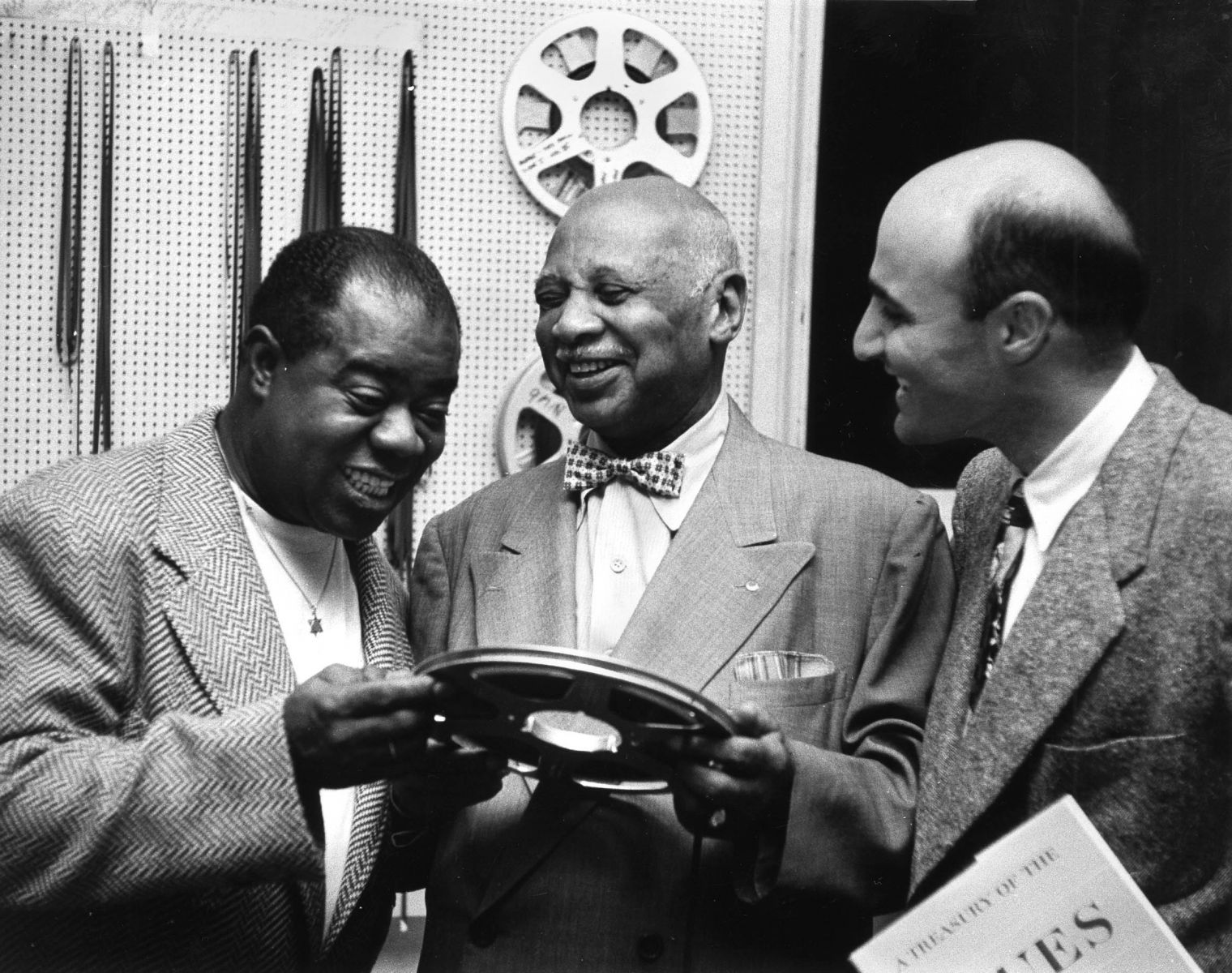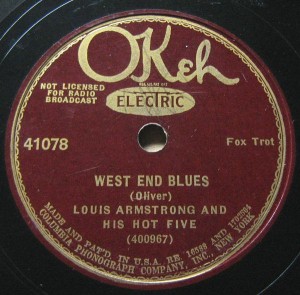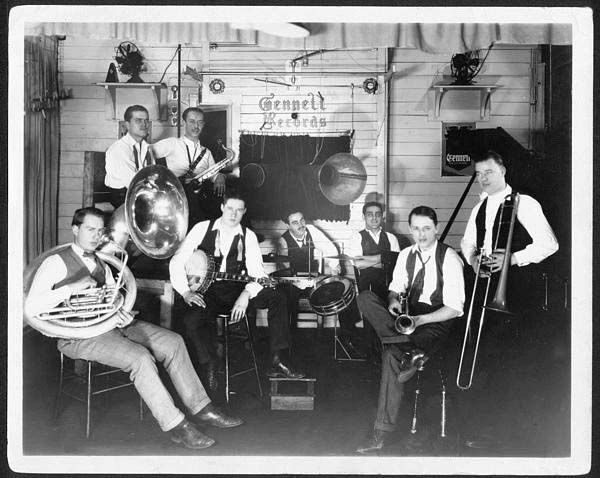.jpg)
Louis Armstrong. Photo courtesy lastfm.
This week Riverwalk Jazz brings together music of two pioneers of jazz—cornetist and trumpeter Louis Armstrong, often cited among the greatest contributors to jazz, and Bix Beiderbecke, the self-taught cornetist whose thoughtful, lyrical approach had an enormous effect on jazz in the 1920s.
On the surface, Louis Armstrong and Bix Beiderbecke were about as different as two human beings could be. At a time when the country was completely divided along lines of race, Bix was white and Armstrong black. Beiderbecke was born into a life of comfort and privilege on a peaceful, tree-lined avenue in Davenport, Iowa. Louis Armstrong grew up in poverty in a shantytown on the back streets of New Orleans, where basic needs like a full stomach and a pair of shoes were rarely met. Louis Armstrong beat the odds so heavily stacked against him and had a long, rich life, making contributions in jazz unsurpassed to this day. Bix, on the other hand, had a short, brilliant career. He was destroyed by alcohol and died broke and alone before the age of 30.
.jpg)
Bix Beiderbecke. Photo in public domain.
Bix and Louis had some things in common—they both possessed musical genius, and they both had a passionate, almost religious devotion to jazz. According to many musicians who knew them, they also shared an affection and appreciation for each other’s work. Drummer Baby Dodds recalled that Bix and Louis first met in the summer of 1920 when the Mississippi riverboat, the S.S. Capitol, pulled into Davenport with Armstrong on board playing cornet with Fate Marable’s Orchestra. Bix showed up at the dock from his nearby family home and fell in love with Armstrong’s playing.
Louis Armstrong Playlist Music Notes:
“Dippermouth Blues,” composed by Louis Armstrong and his mentor King Oliver, is a number the cornet duo often played together at the Lincoln Gardens on the South Side of Chicago in the early 20s. The King Oliver Creole Jazz Band first recorded “Dippermouth” in 1923 with a youthful Armstrong, still a hayseed from the wrong side of the tracks in New Orleans, playing second cornet. Deeply attached to this early classic, Armstrong would perform and record this piece throughout his career.

Armstrong with Avakian and W.C. Handy, 1954. Photo courtesy wuftfm.org.
Decades later, in 1954, Armstrong went into the recording studio with producer George Avakian to record an album of traditional blues composed and collected by another pioneer of American music, W.C. Handy. By then, the middle-aged Armstrong was unsurpassed on his instrument and a vital contributor to jazz. “Chantez Les Bas” (“Sing ‘em Low”) was one of Handy’s tunes recorded at that session. Here, the track begins with Armstrong’s magnificent solo from the original recording, then crossfades live to The Jim Cullum Jazz Band on stage at The Landing with bandleader Cullum taking the lead on cornet.
“Ballin' The Jack,” performed here by The Jim Cullum Jazz Band, first captured Armstrong’s imagination when he heard it played on the streets of New Orleans. The tune was written to cash in on a dance craze of that name in 1913. Jazz cornetist Bunk Johnson often said it was one of the first tunes the 12-year-old Armstrong learned to play.

"West End Blues" record label courtesy of keepswinging blogspot.
In June 1928 Louis Armstrong made history with a series of recordings for Columbia with his Hot Five, an ensemble that included pianist Earl Hines. Their performance of King Oliver’s masterpiece “West End Blues” is a landmark recording in jazz, inducted into the Grammy Hall of Fame in 1979. On this broadcast, New Orleans trumpet giant Nicholas Payton joins The Jim Cullum Jazz Band to offer their interpretation of this fascinating multi-strain, twelve-bar blues.
Armstrong and Beiderbecke would meet again a few years after that initial encounter on the excursion boat in Davenport, Iowa. By then, both jazzmen had come up in the world and were headlining in Chicago—Bix on the North Side and Louis on the South. Trumpeter Doc Cheatham recalls, “Everything was Bix Beiderbecke back then. But on the South Side, there was Louis Armstrong, who brought out so many beautiful records that he overpowered everybody.” Saxophonist Bud Freeman said, “Louis loved Bix and Bix loved Louis, of course. Whenever Bix would come to town and go down to hear Louis Armstrong at the Sunset [Café], we’d find out about it and go down there and sit at a table with Bix.”
In 1924 Armstrong and Beiderbecke made their New York City debuts about the same time. Bix was with the Wolverines at the Cinderella Ballroom and Louis was appearing with Fletcher Henderson’s Orchestra at the Roseland. Some years later Armstrong recalled being in the audience for a concert on July 22, 1928. Bix had returned to Chicago as star soloist with the Paul Whiteman Orchestra and Armstrong remembered Bix’s performance that night, like this: “All of a sudden Bix stood up and took a solo and those pretty notes went right through me. You take a man with a pure tone like Bix and no matter how loud the other fellas in the band may be blowing, that pure tone will cut through it all.”
.jpg)
Portrait of Bix Beiderbecke. Photo in public domain.
Bix Beiderbecke Playlist Music Notes:
On this broadcast, Jim Cullum and his Band pay tribute to Bix with a series of tunes from the recorded output of his short career. Bix was still at his peak in July 7, 1928 when he recorded “Wa Da Da. ”
Bix Beiderbecke is best known for his lyrical cornet solos but throughout his life he continued to play piano—the first instrument he learned as a boy. “In A Mist” is an extraordinary piano composition Bix wrote in the 1920s; it sounds contemporary today, almost a century later. Longtime Cullum Band pianist and arranger John Sheridan performs the solo piano version heard here.
Reflecting on Bix Beiderbecke’s contribution to jazz, Jim Cullum says, “One of Bix’s true disciples was guitarist Eddie Condon. He wrote about hearing Bix’s cornet for the first time: ‘Beiderbecke took out a silver cornet. He put it to his lips and blew a phrase. The sound came out like a girl saying “yes.”’
Others have described that Beiderbecke sound as a ‘padded mallet striking a chime,’ or like ‘pearls falling onto velvet.’ Here’s the way I hear it: it’s a fat sound, broader and less strident, darker and more mellow than other cornet players, but it’s not just dark and mellow, it has a hollow ring that sometimes reminds me of a bell. And when Bix bears down, sometimes he gets a brassy edge on the top of all that sound. For me, it’s the most beautiful musical sound I’ve ever heard. Like many other Bix-influenced players, I don’t want to simply copy Bix but I do listen to the Master playing in my head, and sometimes I work to see just how fat the sound can get.”
Bix Beiderbecke made “Singin' the Blues” famous in a 1927 recording under the leadership of his longtime collaborator, saxophonist Frank Trumbauer. The Jim Cullum Jazz Band pays tribute to Beiderbecke and Trumbauer with their interpretation.

Bix and the Wolverines, 1924. Photo in public domain.
Bix first made a name for himself between 1923 and 24, playing with a group of young guys in the Midwest who called themselves the Wolverine Orchestra. He took a giant step up in the popular entertainment world when he left the Wolverines to play with the Paul Whiteman Orchestra, then the biggest act in US show business. One of the hot, driving tunes Bix recorded with Whiteman was “San.”
.jpg)
"Singin' the Blues" record label courtesy of keepswinging blogspot.
“Tiger Rag,” a hit in 1920 for the Original Dixieland Jazz Band, was later played and recorded by both Armstrong and Beiderbecke. Bix and the Wolverines made a famous recording on June 20, 1924 during their last session at the Gennett studio in Richmond, Indiana. Armstrong played “Tiger Rag” nightly for years as a spectacular feature. He recorded the tune at least four times in his career, first on May 1, 1930 under the name “Louis Armstrong and His Orchestra” and again in October 1938 with Fats Waller on piano, Jack Teagarden on trombone and Bud Freeman on tenor saxophone, for a radio program with Martin Bloch. Our version this week features New Orleans trumpet star Nicholas Payton sitting in with The Jim Cullum Jazz Band.
Photo credit for Home Page: Trumpeter Nicholas Payton. Courtesy of landing.com
Text based on Riverwalk Jazz script by Margaret Moos Pick ©1999

